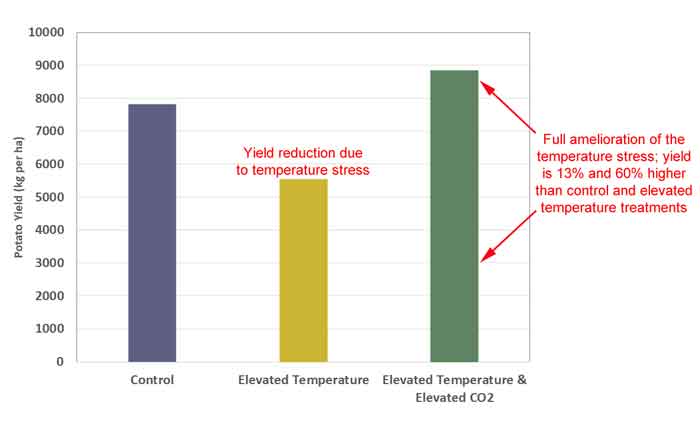| Tweet | Follow @co2science |
Paper Reviewed
Yubi, Y., Jun, L., Haiyang, N. and Xiuyun, Z. 2020. Combined impact of elevated CO2 concentration and climatic warming on potato yield and quality in semi-arid regions. Potato Research, https://doi.org/10.1007/s11540-020-09466-w.
Setting the stage for their work, Yubi et al. (2020) write "the impacts of climate warming and elevated CO2 on plant photosynthesis, physiology and ecology are popular topics in plant physiological and ecological research," citing the results of multiple research studies. However, they add "there are no reports available concerning the response of potatoes to the combined effects of warming and elevated CO2 concentrations in semi-arid regions of the loess plateau in China," which is a major potato growing region. This circumstance, combined with the fact that potato is the fourth major global food crop behind rice, wheat and maize, led the team of four Chinese researchers to conduct their own study examining the combined effects of elevated CO2 and warming on the development and growth of a key potato cultivar (cv. New Daping).
The study was conducted at the Dingxi Drought and Ecological Environmental Experiment Base of the Lanzhou Institute of Arid Meteorology, China Meteorological Administration. There, the scientists grew the potatoes (Solanum tuberisum) for the full growing season in the field in open-top chambers under one of three treatments: control (ambient temperatures and ambient CO2 values of ~370 ppm)), elevated temperature (ambient CO2 and temperatures elevated by infrared heaters to 2°C above ambient) and elevated temperature/elevated CO2 (temperatures maintained at 2°C above ambient and CO2 concentrations of 650 ppm). Elevated CO2 values were only maintained during the daylight hours (from 0700 to 1900 hours each day).
In discussing the impacts of the three treatments on potato growth and development, Yubi et al. report that, relative to control, the net photosynthetic rate of potato leaves during the earlygrowing season was enhanced by 22-140% (average of 85%) in the elevated temperature treatment and by 100-500% (average of 210%) in the combined elevated temperature and elevated CO2 treatment. Such stimulation in net photosynthesis was largely responsible for measured improvements in plant water use efficiency in these two treatments relative to control as well.
With respect to potato yield, which is a key parameter for food security, Yubi et al. report "the yield in the elevated temperature treatment was low because potato crops prefer cool temperatures" and "warming restricts tuber growth." However, they add that increasing the CO2 concentration ameliorated this stress by improving net photosynthesis and plant water use efficiency, which combination of factors "resulted in greater dry matter accumulation [and] promotes the increase of economic yields [for potato growers]." Indeed, as shown in Figure 1, yields in the combined elevated temperature and elevated CO2 treatment were 13% greater than the control treatment and a whopping 60% greater than the elevated temperature treatment.

Figure 1. Potato yield (kg ha-1) of plants grown in open-top chambers under three temperature and atmospheric CO2 treatments: Control (370 ppm CO2 and ambient temperatures), Elevated Temperature (370 ppm CO2 and temperatures 2°C above ambient) and Elevated Temperature & Elevated CO2 (650 ppm CO2 and temperatures 2°C above ambient). Data for this figure were obtained from Table 2 of Yubi et al. (2020).




